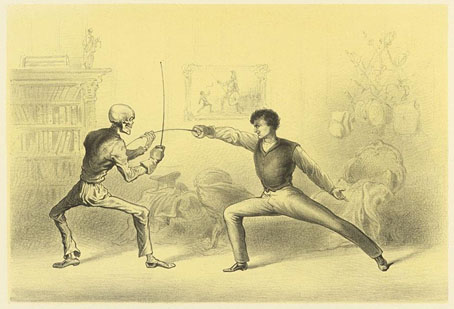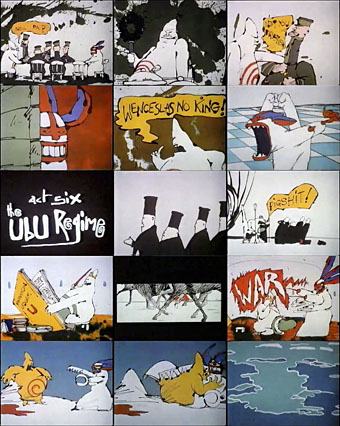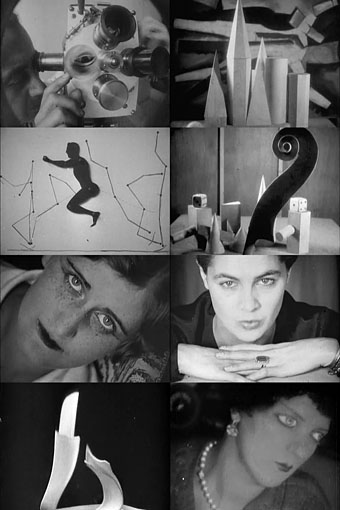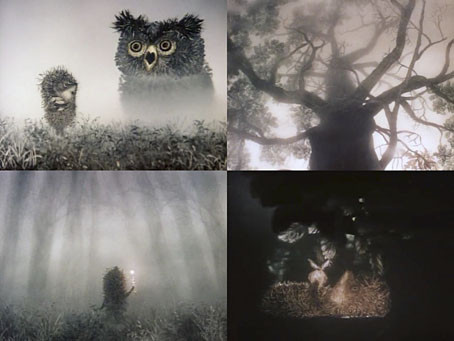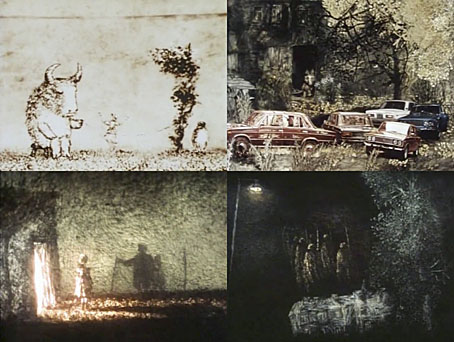Earlier this week Mr BibliOdyssey posted a link on Twitter to a blog entry of his from 2008, a collection of prints by Dutch artist Alexander Ver Huell (1822–1897). If I’d seen his post originally I didn’t recall it so this swordfight gives me an opportunity to draw attention to Ver Huell’s macabre and diabolical work. This unwinnable duel brings to mind the battle with the band of skeletons from Ray Harryhausen’s Jason and the Argonauts (1963), one of my favourite things in the whole world when I was 10. Given how many of the pictures in the Men with swords archive have a quasi-classical theme it’s perhaps appropriate to list Jason and co. among them.
Category: {animation}
Animated films
Three Fragments of a Lost Tale
I hadn’t come across sculptor John Frame’s animated work before so my thanks to John Burridge for the recommendation. Three Fragments of a Lost Tale is part of a larger project, The Tale of The Crippled Boy, which is described at Frame’s website. Being a collection of fragments, this film is necessarily mysterious although I seldom worry about that. One quality of animation I’ve always enjoyed is its ability to convey the disjunctions and strange atmospheres of dream states, something it often does more effectively than anything else.
Previously on { feuilleton }
• Brothers Quay scarcities
• Achilles by Barry JC Purves
• The Torchbearer by Václav Svankmajer
Ubu
One last film post for a very busy week. Ubu is a highly-stylised animated adaptation of Alfred Jarry’s Ubu Roi. This was a British production directed in 1978 by Geoff Dunbar who employs an ink-spattered style reminiscent of Ralph Steadman’s drawings; in place of vocal dramatisation Pa and Ma Ubu shriek horribly and occasionally spit out speech balloons. As a condensation of the play, and a taste of Jarry’s grotesquery, this feels a lot closer to its source than Jean-Christophe Averty’s 1965 film which seems polite by comparison. Ubu took a long time to arrive on YouTube so watch it while you can, it may well vanish again.
Previously on { feuilleton }
• Bring Me the Head of Ubu Roi
Emak-Bakia
Posts this week will tend towards the brief since I’m spending all my time finishing Reverbstorm.
I thought I’d already posted something about Emak-Bakia, a 16-minute “cinépoème” by Man Ray from 1926, but it seems not. This is another of those short experimental films that proliferated between the wars, and a particularly inventive one with Man Ray throwing together every camera trick he could manage; he even throws the camera in the air at one point, having earlier driven over it. There’s also bits of animation, many shots of revolving sculptures and the artist’s customary emphasis on attractive women. Watch it at Vimeo or download it from Ubuweb.
Previously on { feuilleton }
• Un Chien Andalou
• Ballet Mécanique
• Dreams That Money Can Buy
• La femme 100 têtes by Eric Duvivier
• Entr’acte by René Clair
Yuri Norstein animations
Hedgehog in the Fog (1975).
One more animation post before I move onto other things. Since the 1970s Russian animator Yuri Norstein has been regarded as one of the greatest living practitioners of the medium despite having only made a handful of films. Hedgehog in the Fog is a 10-minute piece with a self-explanatory title: a hedgehog sets out one evening to visit his friend, the bear, but before he can reach the bear’s house he has to cross a fog-filled field. Norstein’s animation style involves the skillful manipulation of hand-drawn paper shapes which in this film and the later Tale of Tales achieve a remarkable sense of depth and solidity. The fog effects in Hedgehog are especially striking, created using layers of translucent paper.
Tale of Tales (1979).
The 29-minute Tale of Tales takes the same technique but lifts the animation into a different league, an elusive and (for want of a better term) poetic meditation on life and memory whose central figure is a small grey wolf borrowed from the Russian lullaby sung in the opening scene. The film’s Wikipedia note compares Tale of Tales to Andrei Tarkovsky’s Mirror (1975), and for once the hyperbole feels justified. There’s the same concentration on natural elements such as fire, wind and water, while the recurrent wordless tableaux of a family whose members comprise a poet, a bull with a skipping-rope, and a talking cat might be compared with Tarkovsky’s dream sequences. If meaning here seems reluctant to disclose itself (and why does everything have to mean something anyway?) then that’s all the more reason to watch it again.
Since 1979 Norstein has been working sporadically on a feature-length adaptation of Gogol’s The Overcoat, work on which has been endlessly delayed due to lack of resources and the animator’s painstaking production methods. A few clips can be found on YouTube if you hunt around. Here’s hoping we get to see the finished film soon.
Previously on { feuilleton }
• Barta’s Golem

